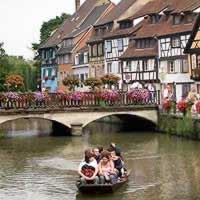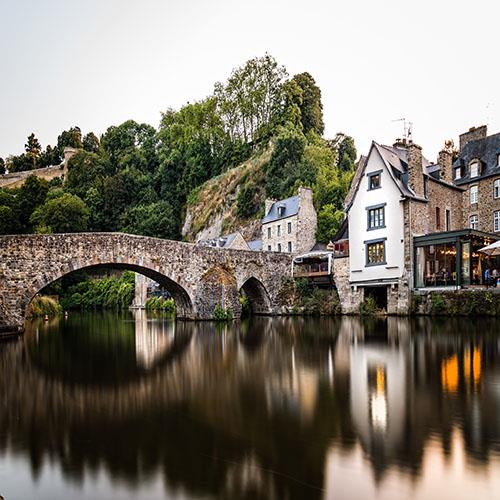France's Most Charming Towns and Villages

Amboise
Straddling the widest stretch of the Loire river is the tiny town of Amboise, once home of the French royal court. The town boasts two beautiful castles: Château d’Amboise, a royal palace, and Château du Close Lucé, a manor house where Leonardo da Vinci spent his last years. Stroll the narrow streets with the timber-framed houses, the key streets and sights are close to the chateau and the Michel Debré Square. Walk up to the Église Saint-Denis, an old church located on a hill close to the center. From the small Ile d’Or island there’s a marvelous view of Amboise and its royal palace reflecting in the Loire River.

Bayeux
Beautiful Bayeux is a town that played an immense role in French history. It's the perfect base for historic Normandy - the site of the Norman invasion of France in 1066 and WWII's D-Day landings of 1944. Most people go to Bayeux to see the thousand year old and exceptionally long, Bayeux Tapestry (actually an embroidery) that chronicles the events leading up to William’s invasion of France. The town is also home to many remnants of WWII that are found throughout Bayeux in the form of museums and memorials.
While so many of Normandy’s towns took a beating during the Second World War, Bayeux itself miraculously came out unscathed, the result of which is a stunning Old Town that the Aure river gently flows through. It is full of medieval architecture with honey colored stone buildings topped with black slate roofs and flowing flower boxes that spill into the narrow lanes. Be sure to keep an eye out for the historic waterwheel, a notable Bayeux landmark that makes an appearance in most photos taken of the city, and lends to Bayeux’s charm.

Aix-en-Provence
Aix-en-Provence has a relaxed way of life, Provencal charm that is bathed in the sunshine of its beautiful climate, and an elegance that reflects its noble heritage. It is known as the “City of Counts” because the Counts of Provence once lived here, Aix-en-Provence has several magnificent old aristocratic palaces. Stroll the tree-lined streets and stately squares, and enjoy the hundreds of fountains, Aix-en-Provence is called the “City of a Thousand Fountains.”
Explore the city's two interesting historic areas: Vieil Aix and Mazaris quarter divided by the fabulous avenue Cours Mirabeau. Other cultural attractions include the world-Class Garnet Museum, Cézanne's art studio, and a trail of sites that Cézanne frequented. The provincial area is a perfect getaway from the bustling city - walk around the beautiful gardens, appreciate work in art galleries, and shop at local markets.

Colmar
The picturesque town of Colmar sits amid the vine-covered foothills of the southern Vosges Mountains boasting a plethora of historic attractions. Its quaint cobblestone streets twist and turn into tiny alleys with vibrant colors, beautiful canals, and Alsatian half-timbered houses that look like a picture out of a storybook. Its mostly pedestrian center is a canvas of brightly tiled roofs and even brighter facades that has remained relatively unchanged over the centuries. Colmar is one of the best places to explore the enchantment and historic attractions of the Alsace region.

Annecy
Often referred to as “Venice Of the Alps” because of its picturesque waterways, Annecy has all the attributes of a fairy-tale scene, with white swans gliding through waterways and a backdrop of snow capped mountains. Wander through the Old Town (Vieille Ville) and it’s myriad of cobblestone streets lined with pastel-painted houses with wrought-iron balconies and geranium flowing windowsills. Nearby are magnificent nature sites that inspire outdoor activities.

Saint-Paul de Vence
The old town of Saint-Paul de Vence was built on a rocky peak, from which there is a view of the whole area. The village has preserved many buildings from the Middle ages including the walls that surround it, the myriad of cobbled streets and several small chapels. The fabulous view of the countryside in particular attracted several 20th century artists, who have been coming here since 1920 such as Picasso, Dufy, Matisse, and James Prevert to name a few. Today, Maeght Founding in Saint-Paul de Vence houses a remarkable collection of paintings of the great masters who lived in the village. Many art galleries also line the streets, showcasing local artists’ creations.

Pau
Pau is most famous for being the birthplace of the beloved French king, Henry IV (born in 1553 and crowned in 1572). His magnificent Renaissance palace is one of the most well-preserved castles in France. The Château de Pau has a sumptuous renovated interior, which gives visitors a sense of the luxury and grandeur that surrounded Henry IV. Pau has several museums, including a large Musée des Beaux Arts, or Fine Arts Museum, and the Musée Bernadotte, a historic house and the birthplace of Jean-Baptiste Bernadotte, who became king of Sweden.

Dinan
Cobblestone streets and half-timbered buildings still exist in Dinan, considered one of the most charming and well-preserved medieval villages in Brittany. It was once a fortified stronghold of the Dukes of Brittany and for centuries the town has served as a hub of cultural and commercial activity, from the original merchants and traders to today’s artists and craftspeople. It is a lovely place to meander, with a lively market on Thursday morning in Place du Guesclin, Dinan’s town square.

Amiens
Amiens, the former capital of Picardy, was beautifully rebuilt after WWII. It sits on the banks of the Somme, where it is divided into a series of canals and irrigation networks. While Amiens is primarily known for its mighty Gothic cathedral, you must also visit les hortillonnages, a series of lovely floating gardens you can explore by small boats through the surrounding canals.

St. Malo
The port city of St. Malo is a popular destination and one of the gems of the Brittany coast. Exploring the cobbled streets is like stepping back in time. It’s a city of privateers (pirates) where the land meets the sea and where myth is often hard to separate from legend and history itself. Wander through the ramparts to reach St Vincent Gate’s steps. From the top, the views are breathtaking, with one of the world’s greatest tidal ranges.

Bergerac
On the serene Dordogne River, Bergerac is a medieval town of corbelled houses surrounded by green countryside with vineyards and farms. Even though it’s the second largest town in Dordogne, the historic center is relatively small, laid back, and you guessed it, charming! Enjoy beautiful river walks, boat trips, a nice bridge and several lovely restaurants.

Chamonix
Situated in the heart of the French Alps in close proximity to Switzerland and Italy, the quaint town of Chamonix offers a unique charm and undeniable breathtaking views. There are few sights on Earth that compare to the spectacle of Mont Blanc, the most famous mountain on the French Alps and the highest point in Europe. Chamonix sits in the shadow of Mont Blanc’s majestic peak, filled with quaint restaurants, cafes, shops, stylish hotels, and old-fashioned auberges (inns). The town has been world-renowned as a ski resort ever since the 1924 Winter Olympics, while in summer the same lifts access hiking and biking trails. Besides skiing, Chamonix is one of the best places to visit in France for hiking, rock climbing, paragliding, golf, and tennis. It’s also worth the journey just to breathe in the fresh Alpine air, and soak up the inspiring scenery.

Honfleur
Colorful and bursting with life, it’s hard to remember that Honfleur was originally built with the sole purpose of trading. As the years have passed, this seaside town is now famed for attracting impressionist painters. You can see the art up close among the museums and modern galleries while strolling the narrow cobbled alleyways. The town is both cultural and wealthy, noticeable by the yachts that surround Vieux Bassin (the heart of the port), and the rows upon rows of high-rise homes packed tightly together. The port is one of the most picturesque places and most photographed spots in Honfleur and it is easy to see why. The magnificent Honfleur Port is surrounded by the 17th and 18th-century narrow houses that creates an atmosphere like no other. And with more than 1,000 years of history, it’s really worth a visit if you love the ocean and medieval architecture.

Loches
On a hill resting on the banks of the Indre River in the heart of the Loire Valley, Loches is a lovely medieval riverside town that remains one of the best-preserved cities in France today. Wander the shadowy cobblestone streets, take in the stunning views of the forest landscape, and enjoy the lively marketplace. You’ll notice that Loches retains its authenticity and charm that is hard to find elsewhere.
The town is packed with history and heritage sites, but also stands at a crossroads of walking and cycling trails for those who want to explore the tranquility of the surrounding countryside. One of the most spectacular ways to approach the town is from the Indre à Vélo cycle trail, passing the ruined abbey of Beaulieu-lès-Loches, and heading through the nature reserve of Les Prairies du Roy.

La Rochelle
On the edge of the old Atlantic seaport, La Rochelle has beautifully maintained its architecture, making it one of the most picturesque and historically rich cities to visit. It was founded as a fishing village in the 10th century on a rocky platform in the center of a marshland. From the 14th to 16th centuries, La Rochelle was one of France’s great maritime cities. The early French settlers of Canada, including the founders of Montreal, set sail from here in the 17th century.
Today, it is known as La Ville Blanche (the White City) because of its luminous limestone facades that glow so brightly in the coastal sunlight. From its half-timbered houses protected from the salt air by slate tiles, its arcaded streets, and excellent collection of lighthouses, you’ll discover strong reminders of its magnificent seafaring heritage. While many of La Rochelle’s sights are old, the city is riddled with high-rise condos and home to the largest pleasure-boat basin in Europe. In the summer months, the city is overrun with visitors.

Perpignan
Perpignan, located in the Pyrenees-Orientales region, is a flourishing town with around 100,000 habitants. Historically, Perpignan was the former capital of the kingdom of Mallorca, a Mediterranean power that stretched northwards as far as Montpellier, making it a Catalan cultural and business hub with a multicultural status. Stroll through the medieval streets to Le Castillet, or tour Palais des Rois de Majorque, to see its Catalan heritage. The old town is dotted with grand architectural throwbacks to its former glories as a Spanish city. It’s common for this cultural French-Spanish blend to spill out into the festive streets, especially at night when the late-night culture and love of partying takes place.